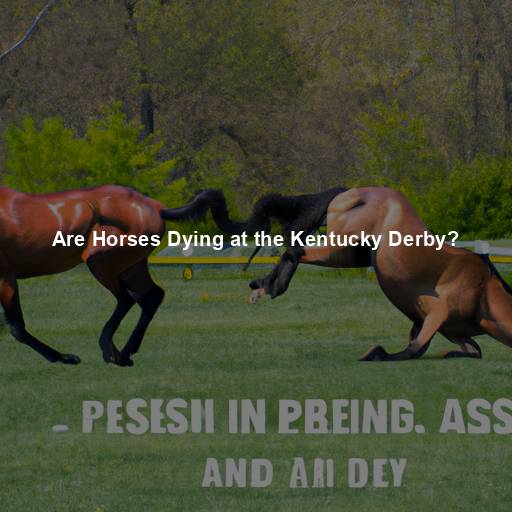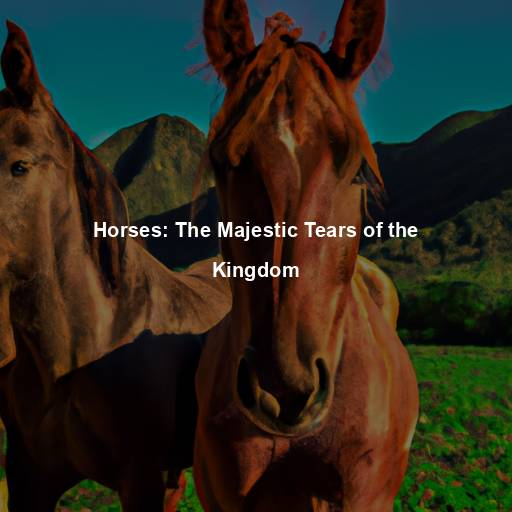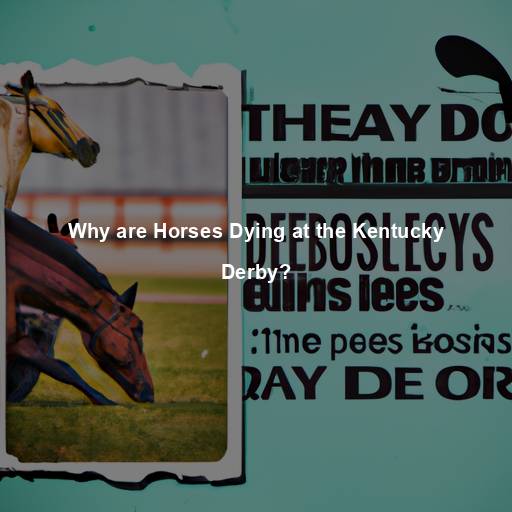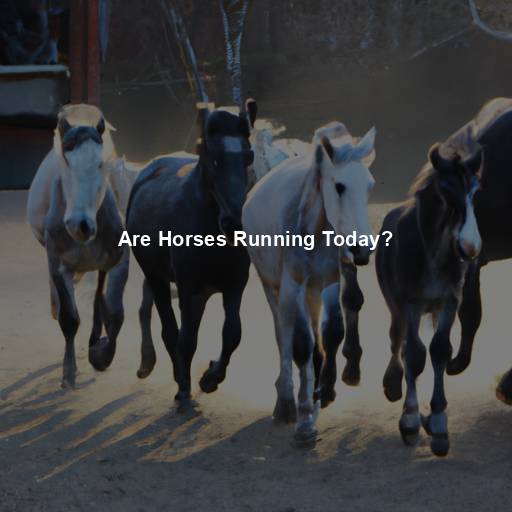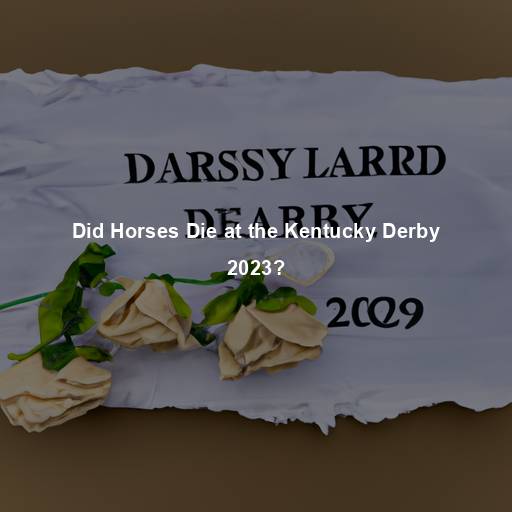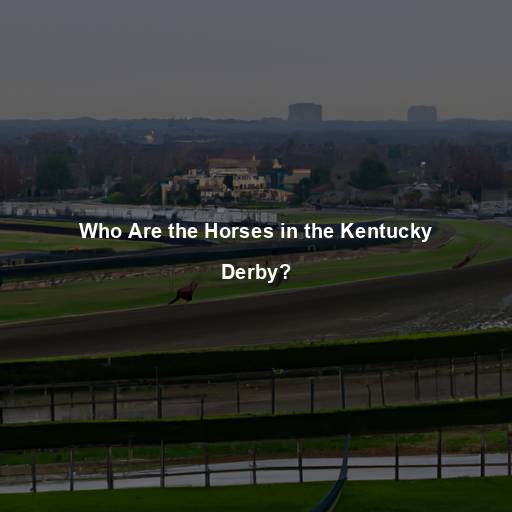Are Horses Dying at the Kentucky Derby?
Last Updated on November 18, 2023 by Evan
Contents [hide]
- 1 The Glorious Tradition of the Kentucky Derby
- 2 The Dark Side of the Derby
- 3 A Call for Ongoing Evaluation
- 4 Evolving for the Better
- 5 The Way Forward
- 6 Ethical Considerations
- 7 Looking Beyond the Derby
- 8 FAQs – Are Horses Dying at the Kentucky Derby?
- 8.1 How often do horses die during the Kentucky Derby?
- 8.2 Have any horses died during recent Kentucky Derby races?
- 8.3 Are there any safety measures in place to protect the horses participating in the Kentucky Derby?
- 8.4 What happens if a horse suffers an injury during the Kentucky Derby?
- 8.5 Do horse deaths occur more often in horse racing than in other equestrian disciplines?
- 8.6 How do the organizers ensure the safety of horses during the Kentucky Derby?
- 8.7 What measures are being taken to further reduce the risk of horse injuries during the Kentucky Derby?
The Glorious Tradition of the Kentucky Derby
For more than a hundred years, the thrilling spectacle known as the Kentucky Derby has enthralled spectators worldwide, earning the well-deserved title of “The Most Exciting Two Minutes in Sports”. Taking place on the first Saturday of May at the illustrious Churchill Downs in the heart of Louisville, Kentucky, this extraordinary event celebrates the sheer magnificence of thoroughbred horses in all their majesty, strength, and elegance. As the inaugural race of the distinguished Triple Crown series, the Kentucky Derby is a monumentally significant event within the realm of horse racing, indelibly etched into the fabric of American culture. It’s a true marvel that never ceases to perplex and awe.
The Dark Side of the Derby
When it comes to the Kentucky Derby, there’s no denying the electrifying atmosphere that surrounds this time-honored tradition. However, beneath the glitz and excitement, a veil of uncertainty has settled, fueled by mounting concerns over the well-being of the magnificent equine athletes that grace the tracks. Whispers of mistreatment, troubling injuries, and the heart-wrenching loss of these noble creatures have opened a Pandora’s box of debate, pushing us to ponder the unthinkable: Is the Kentucky Derby costing horses their lives?
The Reality of Horse Injuries
The intensity of the Kentucky Derby, with its high stakes and fiercely competitive atmosphere, undoubtedly puts immense physical strain on the participating horses. It is no secret that horse racing, in general, carries inherent risks. Horses are powerful animals, and accidents can occur, leading to injuries or even death. However, it is essential to analyze these incidents within the broader context of the sport and understand the efforts made to ensure horse welfare.
Safety Measures and Regulations
When it comes to the Kentucky Derby, ensuring the safety of the magnificent horses and fearless jockeys takes center stage. Churchill Downs, as the ultimate host, has left no stone unturned when it comes to implementing a plethora of meticulous safety measures and regulations that aim to minimize any potential risk during the exhilarating race. Rigorous veterinary inspections, track surface maintenance, and a dedicated team of medical professionals on standby all serve as a testament to their unwavering commitment. Moreover, the ever-evolving world of veterinary medicine and cutting-edge training techniques have played a pivotal role in revolutionizing horse care, consequently fortifying the prevention of injuries.
Statistical Analysis: A Closer Look at the Numbers
To gain a more comprehensive understanding of the situation, let us examine the statistics surrounding horse injuries and fatalities at the Kentucky Derby. While any horse injury is tragic, it is essential to put these incidents into perspective. In recent years, the fatality rate at the Kentucky Derby has remained relatively low, with an average of less than 2% of participating horses experiencing fatal injuries. These numbers, while not negligible, demonstrate that significant efforts have been made to prioritize the safety and well-being of the horses.
The Importance of Transparency
Transparency is crucial in addressing concerns about horse welfare at the Kentucky Derby. The public, as well as organizations advocating for animal rights, have a legitimate interest in understanding the realities and risks associated with horse racing. The Kentucky Derby organizers should continue to provide open and honest communication about injury rates, safety measures, and improvements being made to protect the horses. By fostering transparency, trust can be built and misconceptions can be corrected.
Strides Towards a Safer Future
In the dazzling realm of the Kentucky Derby, horse welfare sparks an ever-burning flame of intrigue. From each flicker of concern, the equestrian arena has embarked on a magnificent odyssey to safeguard the majestic creatures and their brave jockeys. Luminous beams of scientific exploration have illuminated the path, revealing the intricate tapestry of equine physiology. Yet, it is the artistry of innovative training techniques and the symphony of cutting-edge technologies that weave the strands together, creating a tapestry that paints a vivid portrait of stewardship.
The Role of Regulation and Enforcement
Regulatory bodies play a vital role in ensuring the welfare of horses in the racing industry. Stricter regulations, enforced by independent organizations, can help prevent instances of mistreatment, drug abuse, and other unethical practices. By holding trainers, owners, and jockeys accountable for their actions, the industry can work towards eliminating any practices that compromise the well-being of the horses and tarnish the reputation of the sport.
Education and Awareness
Amidst the grandeur and adrenaline of the Kentucky Derby, lies an imperative puzzle waiting to be solved: the enhancement of horse welfare. Illuminating this intricate tapestry, one crucial thread emerges – education and awareness. The resounding need to enlighten not only industry experts but also the wider populace about the multifaceted nuances of horse racing and the tireless endeavors undertaken to safeguard these majestic creatures. It is through nurturing a deeper comprehension of the sport, its inherent perils, and the labyrinth of protective measures in place that misconceptions shall dissipate, paving the way for enlightened discussions to flourish.
A Call for Ongoing Evaluation
While significant progress has been made in recent years, the question of whether horses are dying at the Kentucky Derby necessitates ongoing evaluation and improvement. The racing industry must remain committed to the well-being of the horses and continue to implement measures that prioritize their safety. By embracing transparency, regulation, education, and technological advancements, the Kentucky Derby can continue to be a celebrated event without compromising the welfare of the magnificent animals that make it possible.
The Kentucky Derby, a time-honored spectacle, has an inexplicable way of captivating the world with its grandeur and fervor. Yet, amid the pomp and pageantry, questions loom about the well-being of the equine athletes who grace the track. Though some may feel disquieted, it is essential to acknowledge the ongoing endeavors aimed at safeguarding these majestic creatures and enhancing their safety. Only through a concerted alliance can the racing industry strike a delicate balance, preserving the exhilaration that defines the Kentucky Derby while ensuring the utmost care for its equine protagonists.
The Weight of Public Opinion
The Kentucky Derby, beyond being a thrilling event in the racing world, has found itself amidst a swirling storm of concerns related to horse welfare. However, it’s important to acknowledge that these concerns, while originating from within the racing industry, have rippled far beyond its boundaries and into the realm of public opinion. The growing awareness and sensitivity towards animal welfare issues have created a perplexing and urgent need for the racing industry to not only acknowledge these concerns but also to take meaningful action. By valuing horse safety and responding to the changing expectations of a more enlightened audience, the Kentucky Derby can navigate these turbulent waters and emerge as a symbol of responsible horsemanship.
The Economic Factor
While we grapple with the profound ethical dilemmas surrounding horse injuries and deaths, we must also reckon with the perplexing economic ramifications that loom ominously overhead. The racing industry, a fragile ecosystem teetering on the precipice of public opinion, leans heavily on multitudes of revenue streams, from the intoxicating whirlwind of betting windfalls to the generous embrace of sponsorships and the magnificent crowds that grace its races. Alas, the tempestuous tempest that ensues when horse welfare takes a perilous stumble threatens to cast a long, dark shadow upon these very lifelines. In this bewildering maelstrom, however, lies an opportunity for the industry to reclaim its moral compass, safekeeping the noble steeds that grace its tracks, mesmerizing the public, and rekindling their unwavering trust.
Evolving for the Better
Embracing Technology and Innovation
The world of horse racing is on the cusp of a transformative era, as cutting-edge technologies pave the way for unprecedented advancements. With upgraded tracks that offer enhanced traction and reduced risks, and sophisticated monitoring tools that delve into the depths of a horse’s well-being, the industry is experiencing a surge of possibilities. By leveraging the power of data analytics and artificial intelligence, trainers and veterinarians are now equipped with the ability to detect and address potential concerns before they spiral out of control, ensuring the welfare of these magnificent creatures remains a top priority. Innovation has become the driving force behind a new era in racing, where proactive measures and injury prevention are at the forefront of the game.
Collaborative Efforts
The intricacies of horse welfare present a labyrinth of perplexing challenges that can only be conquered through a whimsical dance of collaboration. In this ethereal ballet, trainers, owners, jockeys, veterinarians, and regulatory bodies must intertwine their efforts like a kaleidoscope of vibrant hues, merging their expertise to forge a path towards a harmonious future. By embracing a shared vision, nurturing a symphony of communication, and weaving a tapestry of industry-wide standards, the racing community has the power to forge an indomitable alliance, where the safety and welfare of the mighty equine companions reign supreme.
Expanding Research and Education
In a world where galloping ahead is the norm, harnessing the power of knowledge becomes paramount. Unlocking the secrets of horse physiology, unearthing innovative training methods, and safeguarding against injuries take center stage in the pursuit of excellence. Through a zealous commitment to scientific studies and academic programs dedicated to equine health, the racing industry can navigate the labyrinthine maze of decision-making with fluency and confidence. Education initiatives, meanwhile, dot the landscape, awakening an unwavering consciousness among industry professionals, bridging the ever-widening gap between tradition and cutting-edge advancements, all for the betterment of horse welfare.
The Way Forward
Striking a Balance
The horse welfare discussion surrounding the hallowed grounds of the Kentucky Derby is anything but straightforward. It’s a swirling vortex of complexities, begging us to tread cautiously and navigate the treacherous waters of tradition and compassion. Achieving equilibrium amidst this tempestuous storm requires relentless introspection, open communication, and an unwavering dedication to growth. By fearlessly embracing transformation and aligning with the shifting tides of societal demands, the racing industry can pave the way to a future that harmonizes the thrill of the track with the well-being of its majestic equine athletes.
Celebrating the Equine Athlete
When it comes to the Kentucky Derby, one cannot deny the awe-inspiring nature of the horses involved. These majestic beings exude a unique blend of strength, agility, and sheer beauty that leaves us all mesmerized. It is crucial for the racing industry to embrace a mindset of reverence and empathy towards these exceptional athletes. This means acknowledging their invaluable contributions, prioritizing their welfare above all else, and making decisions that reflect the utmost care for their well-being.
Track Conditions and Surfaces
When it comes to the Kentucky Derby, one cannot underestimate the profound influence of the track’s condition and the surface it presents. The well-being of our beloved horses rests on the shoulders of a meticulously maintained track, one that boasts the ideal consistency and impeccable drainage systems. The key lies in the timely evaluation and diligent upkeep of this racing haven, guaranteeing utmost safety for our equine champions.
Training Methods and Preparations
Preparing horses for the grand stage of the Kentucky Derby is no ordinary feat – it’s a delicate dance between nourishing their physical prowess and guarding against potential injuries. Accomplished trainers wield their expertise to mold the horses into marvels of strength, agility, and endurance. Employing a strategic approach, they carefully calibrate the horses’ workouts, with gradual conditioning and well-timed rest periods, to ensure they reach peak performance without risking harm. As these majestic creatures embark on the epic Derby journey, their trainers’ meticulous methods cast a spell of resilience and protectorship.
Horse Selection and Fitness
Choosing the contenders for the esteemed Kentucky Derby is an intricate dance, where trainers and owners meticulously scrutinize lineage, track records, and physical prowess. Each steed undergoes comprehensive medical evaluations to guarantee only the fittest and most robust horses make the cut. Yet, despite the thorough scrutiny, it’s crucial to recognize that injuries can still emerge, even in the most meticulously groomed and conditioned contenders.
Jockey Skill and Experience
When it comes to horse racing, the jockey holds a power unlike any other. Their finely tuned skills and vast experience hold the key to not only the outcome of the race, but also the welfare of the majestic creatures under their command. With their expert navigation of the track, lightning-fast decision-making abilities, and uncanny ability to handle unexpected situations, experienced jockeys are the unsung heroes of the sport. Their communication with the horses and their unwavering adaptability during the race not only minimizes potential risks, but also sets the stage for a safe and thrilling spectacle.
Ethical Considerations
The Responsibility of the Racing Industry
As the governing body of horse racing, the racing industry has a moral and ethical responsibility to ensure the well-being of the horses. This responsibility extends beyond the Kentucky Derby and encompasses the entire racing calendar. By implementing strict regulations, enforcing ethical standards, and investing in research and development, the industry can work towards creating a safer and more sustainable environment for horse racing.
The Role of Public Awareness
Public awareness and engagement are crucial in effecting change within the racing industry. As concerns regarding horse welfare continue to gain traction, it is important for individuals and organizations to advocate for increased transparency, stricter regulations, and improved safety measures. By raising awareness and putting pressure on industry stakeholders, the public can play a vital role in driving positive change.
The Moral Dilemma of Horse Racing
The ethical quandary at the heart of the horse racing world revolves around the perplexing bundle of risks that cling to the sport like stubborn barnacles. Despite earnest attempts to limit harm, the harsh reality remains that horse racing comes bundled with its fair share of hazards. Society, regulators, and industry aficionados must wrestle with this enigma, gingerly tip-toeing along the tightrope between upholding a cherished tradition and safeguarding the precious lives of the majestic equine participants.
Looking Beyond the Derby
Broadening the Scope of Horse Welfare
While the focus of this discussion has been on the Kentucky Derby, it is important to recognize that horse welfare extends beyond a single race. The racing industry as a whole must prioritize equine health and safety throughout all races, from local tracks to prestigious events. By implementing consistent standards, sharing best practices, and fostering a culture of compassion, the welfare of horses can be improved across the entire racing industry.
Diversifying the Racing Landscape
In the intriguing tapestry of horse racing, the Kentucky Derby stands as a towering monument, captivating horse enthusiasts and igniting the flames of anticipation. Yet, amidst the clamor of the crowd, there lies a need for equilibrium. A mesmerizing solution lies in the art of diversification – a symphony of varied races and formats that can soothe the tensions arising from a sole, grandiose event. By unveiling a kaleidoscope of opportunities, the industry can tame the tempest, casting a brilliant spotlight across the equine realm while soothing the strains and lessening the perils that rest upon the horses’ shoulders.
Exploring Alternative Equestrian Sports
In the vast universe of equine endeavors, horse racing stands as a prominent star. But oh, dear reader, do you know that there exists a captivating constellation of equestrian sports and disciplines? Yes, beyond the thrill of the racetrack, a kaleidoscope of athleticism and grace awaits. Picture the elegance of dressage, where horse and rider pirouette in harmony, or envision the heart-pounding heights of show jumping.
FAQs – Are Horses Dying at the Kentucky Derby?
How often do horses die during the Kentucky Derby?
It’s a rare occurrence when tragedy strikes the Kentucky Derby, with horses losing their lives. Like any sport involving animals, horse racing carries its own set of risks. However, the organizers of this prestigious event, along with the entire racing industry, place utmost importance on the safety and welfare of these majestic creatures. With the passage of time, proactive measures have been put into place to reduce the likelihood of fatal incidents during these high-stakes races.
Have any horses died during recent Kentucky Derby races?
Fortunately, there have been no reported cases of horses dying during the actual Kentucky Derby race in recent years. The event organizers, Churchill Downs Incorporated, constantly strive to improve safety protocols and track conditions to ensure the welfare of the horses and jockeys.
Are there any safety measures in place to protect the horses participating in the Kentucky Derby?
With utmost regard for equine welfare, the Kentucky Derby has embraced an array of precautionary measures to ensure the safety of its noble contenders. Rigorous veterinary inspections serve as an unyielding barrier against any potential impairments, while stringent regulations governing doping and medication further fortify the integrity of this celebrated event. Unwavering attention is paid to track conditions, assuring a terrain that safeguards these illustrious steeds, and continuous monitoring during and after the race ensures their welfare remains paramount.
What happens if a horse suffers an injury during the Kentucky Derby?
When the intensity of the Kentucky Derby sweeps through the air, every precaution is taken to ensure the well-being of the majestic equine athletes. Should a misfortune befall them, a team of dedicated trainers and skilled veterinarians are readily available to administer the required care. In the rare circumstance where a thoroughbred’s injury proves to be detrimental to its racing career, the heartbreaking decision of retirement may loom. It is important, nevertheless, to acknowledge the astonishing rarity of fatal injuries occurring during the heart-stopping moments of the race itself.
Do horse deaths occur more often in horse racing than in other equestrian disciplines?
While any loss of a horse’s life is tragic, it is important to recognize that the fatality rate in horse racing is significantly lower than people often perceive. The industry has made considerable advancements in improving safety protocols, veterinary care, and track conditions to minimize the risks. Comparatively, horse racing has a lower fatality rate than other equestrian disciplines, such as eventing or steeplechase.
How do the organizers ensure the safety of horses during the Kentucky Derby?
The organizers of the Kentucky Derby collaborate closely with various industry experts, including veterinarians, track managers, trainers, and jockeys, to continually analyze and enhance safety practices. This includes regular inspections of the track surface for optimal conditions, enforcing strict medication rules, and implementing rules to prevent dangerous racing behavior. Safety remains a top priority for all involved in the Kentucky Derby.
What measures are being taken to further reduce the risk of horse injuries during the Kentucky Derby?
With an unwavering dedication towards equine welfare, the racing industry, with its crown jewel being the prestigious Kentucky Derby, relentlessly pursues breakthroughs in safety measures. It comprehends the significance of evolving track surfaces, revamping racing practices, and fostering knowledge among all participants. The ultimate objective is to safeguard these majestic creatures and preserve the sport’s time-honored legacy, ensuring its unshakeable endurance.

